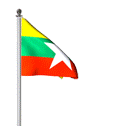Experience authenticity with handicrafts and festivities celebrated throughout the generations
Numerous traditions have been preserved in Bagan and its surrounding villages, including handicrafts such as beautiful lacquerware, basket weaving, sand art painting, woodcarving and bronze wares.





